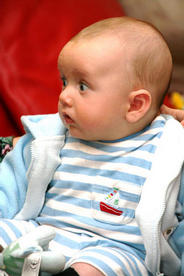Prevnar Vaccination
The Prevnar vaccine, for pneumonia and pneumococcal meningitis, has been in use in the United States.
The annual incidence for pneumonia in the US is approximately 10 cases per 100,000 people. Incidence for pneumococcal meningitis in young children is approximately 7 cases per 100,000. The death rate for the diseases is 8%, with 25% suffering neurological problems (the data sheet failed to say whether this was permanent or temporary).
Children who aren’t breastfed get more pneumonia and meningitis. Bottle sharing also heightens the risk. Those in organised day care centres are at greater risk, those with a history of middle ear infections and those with a history of prior antibiotic use. It should be noted there are antibiotics in vaccines.
The reason for introducing vaccination is that children are now becoming resistant to antibiotics. But there are other ways to protect your child from pneumonia:
1. Breast feed (see ‘Breast Milk: A Natural Immunisation’ by Joanna Karpasea-Jones).
2. If giving your baby bottles of juice, DON’T share them round with other babies or let your baby drink from another baby’s bottle.
3. Sterilise any soothers/dummies used.
4. Don’t share plates of food, knifes, forks, spoons etc
5. Avoid antibiotics except in the case of life-threatening emergency.
6. If your child has suffered from ear infections, strengthen his immune system with vitamin supplementation, breast milk, a healthy whole grain diet and homeopathic treatment instead of repeated antibiotic use.
7. Avoid day care facilities. If you work, pick a childminder instead as there will be less children in a more homely environment, which lessens the risk of pneumonia.
Side-Effects of Prevnar
50% of recipients will get redness and soreness at the injection site, 21% get a fever (over 100.3 F), chills, general malaise, irritability, drowsiness, decreased appetite, arthritis. 1 in 10,000 cases involves a serious reaction including trouble breathing, hives, having a fast heartbeat and becoming dizzy. Seizures also occurred in 1 in 10,000 – almost all seizures occurred within 4 days of vaccination.
According to the manufacturer, the following reactions may also occur:
Vomiting, diarrhoea, injection site redness, fever over 38 Degrees C, drowsiness, irritability, swelling interfering with movement, seizures, hypotonic hyperesponsive episode, dermatitis, face oedema, angioneurotic oedema, dyspnoea, bronchospasm, anaphylactic shock.
As with other aluminium-containing vaccines, a nodule may occasionally be palpable at the injection site for several weeks.
As the rate for pneumonia is 10 in 100,000 and the rate for serious vaccine side-effects is 1 in 10,000, this makes the risk from the vaccine the same, if not more, than the risk from the disease.
Dangers of Prevnar
1) Superbug ear infections: Doctors have discovered the first germ that is resistant to all drugs approved to treat childhood ear infections. Nine toddlers in Rochester, N.Y., have had the germ and researchers say it may be turning up elsewhere, too.
Prevnar prevents seven strains responsible for most cases of pneumonia, meningitis and deadly bloodstream infections. But dozens more strep strains exist, and some have flourished and become impervious to antibiotics since the vaccine combats the more common strains.
Prevnar is losing its punch because strains not covered by the vaccine are filling the biological niche that the vaccine strains used to occupy, and they are causing disease.
2) Other strains of bacteria: A new study found that children with ear inflammation who were immunized were as likely as nonimmunized children to have other types of bacteria in their nasopharynx. The nasopharynx is located at the back of the throat and has two passages leading to the inner ear, through which bacteria can travel.
See “Effect of pneumococcal conjugate vaccine on nasopharyngeal bacterial colonization during acute otitis media,” by Krystal Revai, M.D., M.P.H., David P. McCormick, M.D., Janak Patel, M.D., and others in the May 2006 Pediatrics 117(5), pp. 1823-1829.

